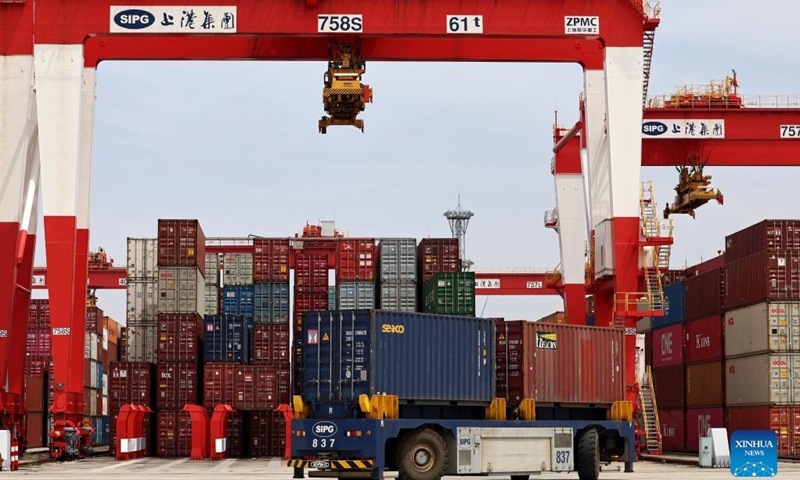
A truck carrying containers is seen at the container dock of Shanghai's Yangshan Port in east China, April 27, 2022. About 25,000 staff members stick to their posts in Shanghai port to guarantee water transportation and improve logistics efficiency amid challenges caused by the recent resurgence of COVID-19 in Shanghai.(Photo: Xinhua)
After over a month of decisive and tough battle against Omicron, Shanghai has been recording declining numbers of new infections at the community level in recent days. The city reported 34 new infections at the community level on Wednesday - the lowest since May 1 - and its daily new case tally continued declining below 5,000, data showed on Thursday. With thousands of key enterprises resuming production, experts forecast that the city will gradually lift the lockdowns by the end of May.
New COVID-19 cases recorded on Wednesday dropped 8 percent from the number on Tuesday, and 34 cases were found outside collective quarantine places. The number of infections found at the community level was also the lowest since May 1 - the day after Shanghai announced that it had cleared all the infections at the community level from April 29 to 30.
The city has continued to conduct citywide nucleic acid and antigen tests for residents during recent days. As of Wednesday, more than 2.3 million residents were put under lockdown involving 11,893 residential communities, while 16.47 million residents were in precaution-level regions, according to local authorities.
For some residents under precaution-level regions where no positive cases have been found for 14 days, one person from a household is allowed to go out to purchase daily necessities within certain areas. In order to avoid large gatherings, some communities strengthened preventive measures.
"Our community only allowed us to move freely within the community and reminded us to avoid gathering," a 41-year-old Shanghai resident surnamed Jin told the Global Times on Thursday, who is living in a community under precaution status.
Local authorities in Shanghai believed that the anti-epidemic measures apparently took effect, as the number of residents in zones under lockdown has been gradually dropping. Meanwhile, more enterprises resumed production, as among over 1,800 key companies, over 70 percent resumed production covering industries such as vehicles, integrated circuits and biomedicine.
The local bus operators are also working on coordinating and deploying personnel, overhauling vehicles and strengthening epidemic prevention and control measures, as part of preparations for the resumption of daily traffic.
A model developed by Yao Maosheng, a professor at the College of Environmental Sciences and Engineering at Peking University, showed that by the end of May, the current infection wave in Shanghai is likely to be contained, and the city will gradually lift the lockdowns by then.
Yao also predicted that new infections will drop below 1,000 around May 19, and the total infection tally could reach 620,000 to 630,000.
Some other experts reached by the Global Times on Thursday also agreed that given the declining daily new infections, the outbreak in Shanghai could be fully controlled by the end of May.
China will surely win the war against COVID-19 with its scientific and effective epidemic control policy that will stand the test of time, according to a meeting of the top leadership on Thursday. "We won the battle against the epidemic in Wuhan, and we will surely win the battle against the virus in Shanghai," said the meeting of the Standing Committee of the Political Bureau of the Communist Party of China (CPC) Central Committee, which was chaired by Xi Jinping, general secretary of the CPC Central Committee.
To coordinate anti-epidemic work and social and economic development, Shanghai has been pushing forward the normalization of nucleic acid testing, which is seen as a measure to normalize or recover social activities amid the epidemic and minimize the impact on the economy.
The normalization of nucleic acid tests only requires people to provide proof of a negative test, and it doesn't cut off transportation, so it's considered as an act to balance epidemic control work while minimizing the impact on people's daily lives, experts said.
As of Wednesday night, Shanghai had nearly 9,000 nucleic acid testing spots, of which about 4,500 were open to the public. The rest will be open in accordance with the needs of work and production resumption as well as the epidemic situation, the local authority said on Thursday.
Cao Heping, an economist from Peking University, told the Global Times on Wednesday that as epidemic-hit Shanghai has achieved the goal of eliminating COVID-19 cases at the community level, an economic recovery could be expected as early as the end of May.
As the industrial and financial hub of China, Shanghai is expected to see a rapid rebound once the epidemic is under control, given the city's enormous economic vitality, he said.
The city's GDP exceeded 4 trillion yuan ($604 billion) in 2021 with a growth rate of 8.1 percent. Such a fast growth rate was thanks to high-quality industries and the real economy in the city, including automobiles, integrated circuits and biomedicine - which were also among the first companies that resumed production amid the epidemic, according to media reports.
"Not only Shanghai's economy but also the country's economy will be largely boosted as soon as the epidemic in Shanghai is put under control, given that the disrupted supply chain of the city has heavily weighed on the country," Tian Yun, former vice director of the Beijing Economic Operation Association, told the Global Times on Thursday.
"The second quarter's performance would be better than that in the first quarter, and the third and fourth quarters' growth rates are likely to reach above 6 percent," he said, predicting that the full-year GDP growth rate could reach 5.5 percent.




